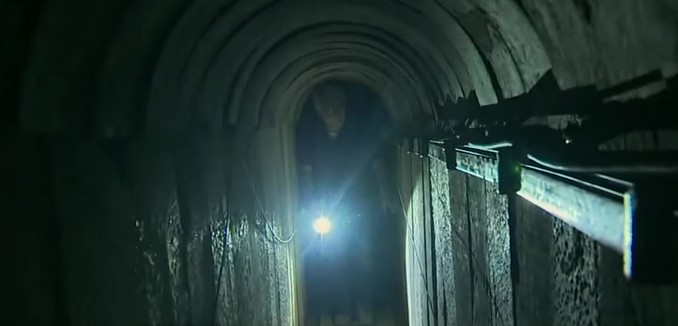Four Palestinian men were found dead in a collapsed smuggling tunnel between the Gaza Strip and the Sinai Peninsula, local authorities said on Sunday, blaming the Egyptian military for flooding the pathway.
The four men “were found dead after the tunnel they were working in was flooded nine days ago by the Egyptian army,” officials in the Gazan city of Rafah near the Egyptian border said, according to Agence France-Presse. It is unclear whether the four men belonged to Hamas, the terrorist group that controls Gaza and maintains a sophisticated network of attack and smuggling tunnels.
While Egypt has not confirmed the allegations, it has in the past destroyed hundreds of Hamas tunnels that were used to transport weapons and terrorists between Gaza and the Sinai.
At least 20 Gazans, most of them members of Hamas, have been killed in tunnel collapses in recent months, AFP reported.
Hamas spends an estimated $40 million of its $100 million military budget on building tunnels into Israel that can be used in future terrorist attacks. In July, an Israeli official estimated that Hamas digs some six miles of tunnels every month. Gen. Yossi Kuperwasser, formerly the head of the research division of Israeli military intelligence and later the director general of the Ministry of Strategic Affairs, told reporters earlier this year that the tunnels were a sign that Hamas is preparing for another war against Israel. “They definitely invest a lot in making the necessary preparations so that in the next round, when they decide to start it, they will be able to inflict the heaviest damage on Israel, including through those tunnels,” he said.
In September, Israel began constructing a $530 million underground barrier along its border with Gaza to prevent more Hamas tunnels from breaching Israeli territory. Israel Defense Forces Chief of Staff Gen. Gadi Eisenkot described the barrier as “the largest project” ever undertaken in Israel’s military history.
In Your Complete Guide to Hamas’ Network of Terror Tunnels, which was published in the April 2016 issue of The Tower Magazine, Dan Feferman observed that Gaza’s civilians ultimately pay the price for Hamas’ efforts to rebuild its tunnels.
There is a tragic side to Hamas’ tunnel strategy. Roughly 9,000 homes were destroyed during Protective Edge, and very few have been rebuilt. This is not Israel’s fault, as building supplies flow regularly into Gaza. But according to declassified intelligence reports, these supplies are routinely stolen by Hamas in order to serve the group’s terrorist purposes. Hamas smuggles in cement, diverts from construction and humanitarian donations, and even raids civilian construction sites in order to rebuild its tunnels. Estimates are that one tunnel can cost a million dollars to build and uses around 50,000 tons of concrete. Close to a million tons of concrete were poured into the terror tunnels before 2014.
The tunnels, in this sense, are a zero-sum game. If the same materials were put into reconstruction, the Gazan people would be better off and, lacking this crucial asymmetric warfare capability, Hamas would be less tempted to attack Israel. On the other hand, with the same limited materials going to terror tunnels, the people of Gaza continue to live in ruins while Hamas rebuilds its war machine.
While Hamas appears to be deterred in the short term, it continues to believe that the tunnels are its only strategic weapon. While it may not be interested in another war, the tunnels continue to be dug for a reason. Once used, however, they lose their effectiveness, as the IDF knows their locations and can thus destroy them. Hamas is well aware of this dilemma. The tunnels essentially leave Israel and Hamas in an arms race—with Israel racing to develop a technological solution before Hamas decides to launch another round of fighting.
[Photo: CNN / YouTube]




